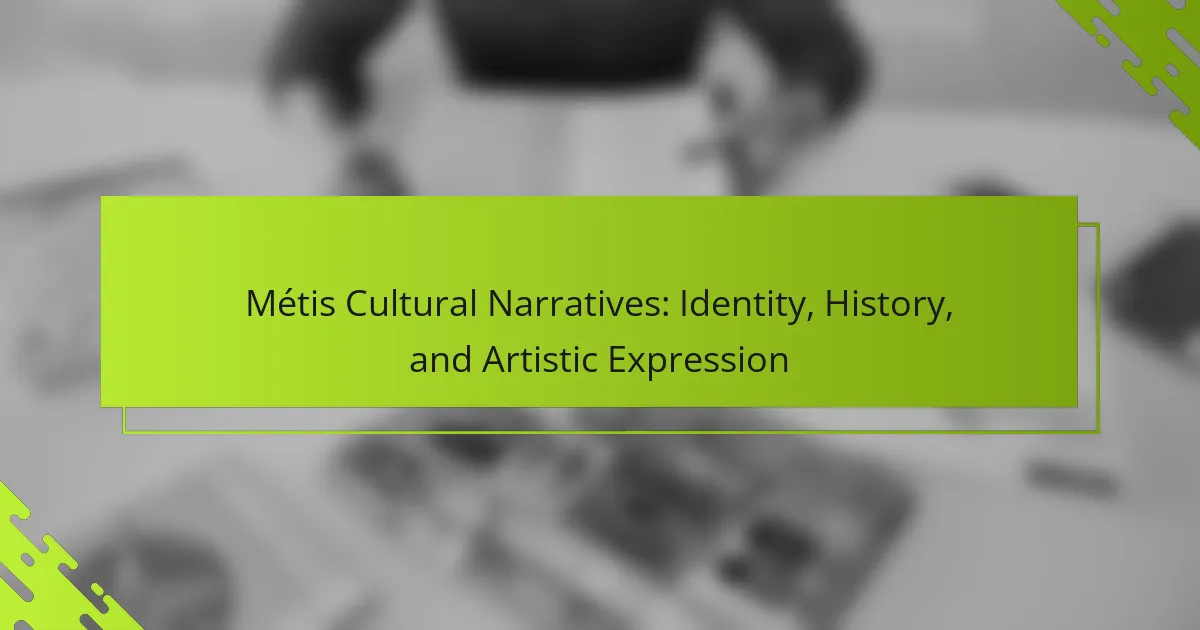Métis cultural narratives play a crucial role in shaping identity and community cohesion while preserving history and values. This article explores key historical milestones that influenced Métis culture, the importance of artistic expression in conveying unique experiences, and the challenges faced in modern society, including misrepresentation and language loss. It also highlights organizations dedicated to promoting Métis heritage and outlines strategies for fostering cultural continuity through storytelling and community engagement.
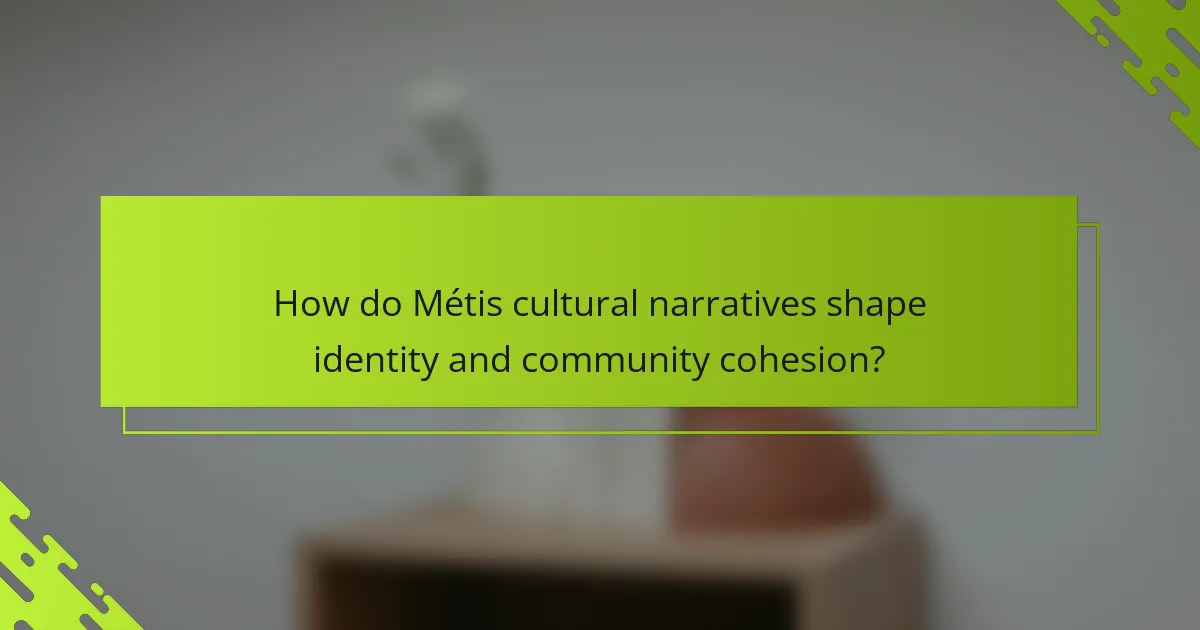
How do Métis cultural narratives shape identity and community cohesion?
Métis cultural narratives significantly shape identity and community cohesion by preserving shared history and values. These narratives foster a sense of belonging among Métis people, reinforcing cultural pride and continuity. Through storytelling, music, and art, the community expresses its unique experiences and resilience. This artistic expression not only highlights the diverse aspects of Métis life but also strengthens interpersonal connections, enhancing social cohesion. As a result, Métis narratives serve as a foundation for collective identity, helping to navigate contemporary challenges while honouring ancestral traditions.
What role do storytelling and oral traditions play in Métis culture?
Storytelling and oral traditions are vital in Métis culture, serving to convey identity, history, and artistic expression. These narratives preserve cultural heritage and foster community connections. They often include unique attributes such as traditional songs and stories that reflect Métis experiences and values. Oral traditions also enable the transmission of knowledge across generations, ensuring the continuity of Métis cultural practices. As a result, storytelling remains a powerful tool for cultural resilience and identity affirmation within Métis communities.
Which historical events have influenced Métis identity formation?
Historical events like the Red River Resistance and the North-West Rebellion significantly shaped Métis identity. These events fostered a sense of community and resilience, influencing cultural narratives and artistic expression. The struggle for rights and recognition established a unique Métis identity that blends Indigenous and European influences. Additionally, the establishment of land claims and cultural preservation initiatives further solidified this identity, allowing for a rich tapestry of Métis history to thrive.
How does the Métis identity differ across regions and communities?
Métis identity varies significantly across regions and communities due to historical, cultural, and social influences. Each community has unique narratives shaped by local experiences, traditions, and interactions with Indigenous and settler populations. For example, Métis in Manitoba may emphasize their Red River roots, while those in British Columbia focus on different cultural practices. This diversity reflects the unique attributes of each community, such as language dialects and artistic expressions, contributing to a rich tapestry of Métis identity across Canada.

What are the key historical milestones in Métis history?
The key historical milestones in Métis history include the Red River Resistance, the establishment of the Métis Nation, and the signing of treaties. These events shaped Métis identity and culture, influencing their political and social landscape. The Red River Resistance in 1869-70 sought to protect Métis land rights and resulted in the creation of Manitoba. The formation of the Métis Nation in the late 19th century solidified their political organization. Treaties signed with the Canadian government recognized Métis land claims, although issues regarding implementation persist.
Which treaties and agreements have impacted Métis rights and recognition?
Several treaties and agreements have significantly influenced Métis rights and recognition. The Métis Nation’s assertion of rights stems from historical documents such as the Manitoba Act of 1870, which recognized Métis land rights and established the province of Manitoba. The Constitution Act of 1982 further affirmed Métis rights under Section 35, acknowledging them as one of the three distinct Indigenous groups in Canada.
Additionally, the 1999 Supreme Court decision in R. v. Powley recognized the Métis’ right to hunt for food, reinforcing their cultural and legal standing. The 2016 Métis Nation Governance Agreement also plays a crucial role, as it outlines self-government and resource-sharing frameworks. These agreements collectively shape the ongoing dialogue around Métis identity, rights, and cultural expression.
How did the Red River and North-West Rebellions shape Métis history?
The Red River and North-West Rebellions significantly influenced Métis history by affirming their identity and rights. These uprisings were pivotal in the struggle for land and cultural recognition, shaping the narrative of Métis resilience. The Red River Rebellion in 1869-70 established the Métis as a distinct political entity, leading to the creation of Manitoba. The North-West Rebellion in 1885 further highlighted their quest for self-determination and justice, fostering a sense of unity among the Métis people. Artistic expressions, such as literature and visual arts, emerged as vital tools for preserving and narrating Métis experiences, reflecting their unique cultural identity.
What is the significance of Louis Riel in Métis cultural narratives?
Louis Riel is a central figure in Métis cultural narratives, symbolising resistance and identity. His leadership during the Red River and North-West Rebellions highlights the struggle for Métis rights and recognition. Riel’s vision for a distinct Métis nation influenced cultural expressions, including literature and art. His legacy fosters a sense of unity and pride within the Métis community, reinforcing their unique heritage and historical significance.
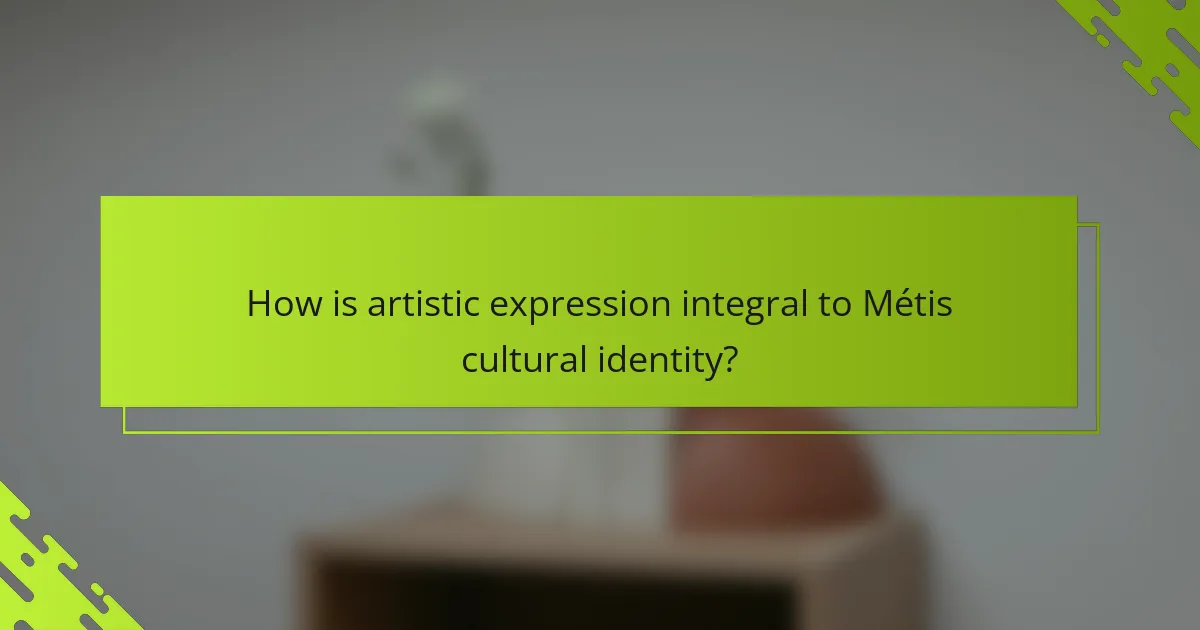
How is artistic expression integral to Métis cultural identity?
Artistic expression is fundamental to Métis cultural identity as it embodies their history, values, and experiences. Through various art forms, such as music, dance, and visual arts, Métis people convey their unique narratives and maintain cultural continuity. Artistic expression fosters community bonds and reinforces a sense of belonging. Additionally, it serves as a medium for storytelling, preserving the Métis heritage and addressing contemporary issues. The integration of traditional and modern techniques in their art highlights the dynamic nature of Métis identity.
What forms of art are most commonly associated with Métis culture?
Métis culture is commonly associated with various forms of art, including beadwork, music, dance, and storytelling. These artistic expressions reflect the unique identity and history of the Métis people. Beadwork often features intricate designs that represent cultural symbols, while music and dance incorporate traditional rhythms and movements. Storytelling serves as a vital medium for passing down history and cultural narratives. Each art form contributes to the preservation and celebration of Métis heritage.
How do Métis artists convey cultural narratives through their work?
Métis artists convey cultural narratives through their work by integrating traditional symbols, stories, and techniques. Their art reflects identity, history, and lived experiences, often addressing themes of resilience and community. For example, visual arts like painting and beadwork utilize motifs that celebrate Métis heritage. Additionally, storytelling through performance art and literature emphasizes the importance of oral traditions. This artistic expression serves as a means of cultural preservation and education, engaging both Métis and non-Métis audiences in understanding their rich narratives.
Which contemporary Métis artists are redefining cultural expression?
Contemporary Métis artists redefining cultural expression include Christi Belcourt, who uses vibrant colours and traditional motifs, and Rosalie Favell, known for her photography that explores identity. These artists blend historical narratives with modern techniques, creating dynamic representations of Métis culture. Their work emphasizes the importance of storytelling and community, reflecting both personal and collective experiences. As a result, they contribute significantly to the broader discourse on Indigenous identity in contemporary art.
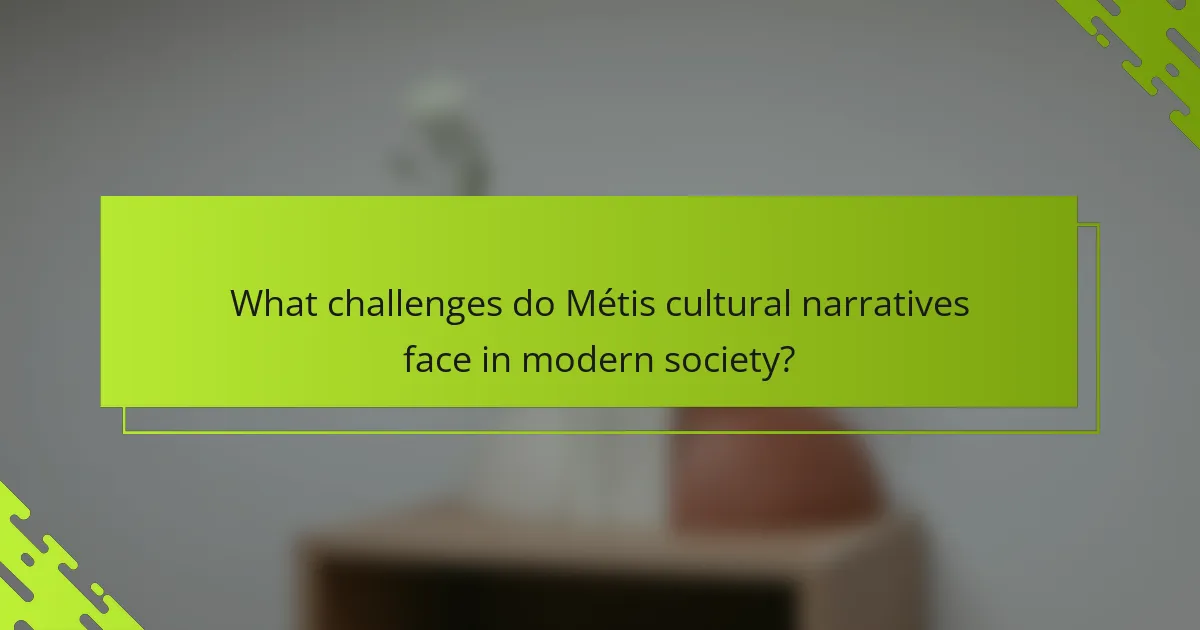
What challenges do Métis cultural narratives face in modern society?
Métis cultural narratives face significant challenges in modern society, including misrepresentation and loss of language. These narratives often struggle against stereotypes that overshadow their rich history and complexity. Additionally, the impact of colonisation has led to diminished access to traditional practices and storytelling methods. As a result, younger generations may feel disconnected from their cultural roots, complicating identity formation. The preservation of Métis art forms and languages is crucial for maintaining cultural continuity amidst these challenges.
How does globalization affect the preservation of Métis culture?
Globalization poses challenges to the preservation of Métis culture by introducing external influences that can dilute traditional practices. The integration of global cultural elements often leads to a loss of unique identity and artistic expression within Métis communities. As a result, younger generations may struggle to connect with their heritage.
Furthermore, economic pressures from globalization can shift focus away from cultural activities, prioritising commercial interests over traditional arts. This shift impacts the transmission of Métis narratives and values, as storytelling and artistic practices may be overshadowed by mainstream culture.
Efforts to preserve Métis culture involve revitalising traditional practices and promoting cultural education. Community initiatives aim to foster a sense of identity and belonging, countering the homogenising effects of globalization. By engaging in cultural exchange and collaboration, Métis communities can assert their identity while navigating the complexities of a globalised world.
What are the impacts of cultural appropriation on Métis artistic expression?
Cultural appropriation negatively impacts Métis artistic expression by diluting authentic narratives and undermining cultural significance. It often leads to misrepresentation and commodification of Métis art, reducing complex identities to stereotypes. This appropriation can stifle genuine creativity, as artists may feel pressured to conform to external expectations rather than express their true heritage. Additionally, it can create barriers to recognition and support for Métis artists, limiting their opportunities in the broader artistic community.
How can Métis narratives be effectively shared in a digital age?
Métis narratives can be effectively shared in a digital age through various innovative methods. Utilizing social media platforms allows for real-time engagement and wider audience reach. Digital storytelling tools enable immersive experiences, showcasing Métis culture through multimedia formats. Collaborations with artists and educators can enhance authenticity and representation. Online workshops and webinars facilitate direct interaction, fostering community involvement. Lastly, archiving and preserving narratives on dedicated websites ensures accessibility and continuity of Métis cultural heritage.
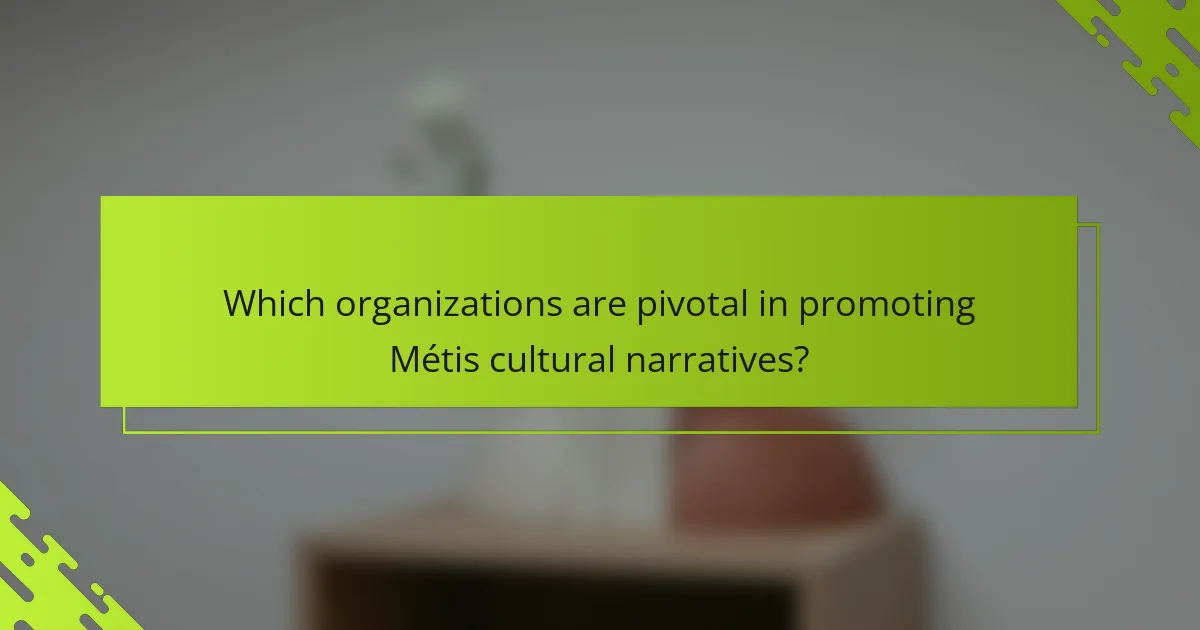
Which organizations are pivotal in promoting Métis cultural narratives?
Organizations pivotal in promoting Métis cultural narratives include the Métis National Council, the Gabriel Dumont Institute, and the Métis Cultural Development Corporation. These entities focus on preserving and sharing Métis identity, history, and artistic expression through various programs and initiatives. Their efforts contribute significantly to the recognition and revitalization of Métis cultural heritage.
How do local and national organizations support Métis artists and storytellers?
Local and national organizations support Métis artists and storytellers through funding, mentorship, and cultural programs. These initiatives enhance visibility and provide resources for artistic expression. For example, organizations like the Métis Nation and arts councils offer grants that empower artists to create and share their work. Additionally, workshops and events foster community engagement, promoting Métis narratives and preserving cultural heritage. Such support strengthens Métis identity and encourages diverse storytelling practices.
What role do educational institutions play in preserving Métis culture?
Educational institutions play a crucial role in preserving Métis culture through education, community engagement, and artistic expression. They serve as platforms for teaching Métis history, language, and traditions, fostering a sense of identity among students. Programs focusing on Métis art and storytelling encourage cultural pride and creativity. Collaboration with Métis communities ensures that educational content reflects authentic narratives, promoting intergenerational knowledge transfer. Additionally, institutions often host cultural events that celebrate Métis heritage, strengthening community bonds and awareness.
How can community initiatives strengthen Métis cultural narratives?
Community initiatives can significantly strengthen Métis cultural narratives by fostering engagement and preserving traditions. These initiatives create platforms for storytelling, artistic expression, and education, ensuring that Métis history and identity are shared and celebrated.
For example, local arts programs can highlight unique Métis art forms, such as beadwork and music, which reflect the community’s heritage. These programs often encourage collaboration among artists, enhancing the visibility of Métis culture.
Additionally, community events like festivals and workshops promote intergenerational knowledge transfer, allowing elders to share stories and teachings with younger generations. This process reinforces cultural identity and continuity.
As a result, these initiatives serve not only to maintain cultural narratives but also to empower Métis communities, fostering pride and resilience in their unique identity.
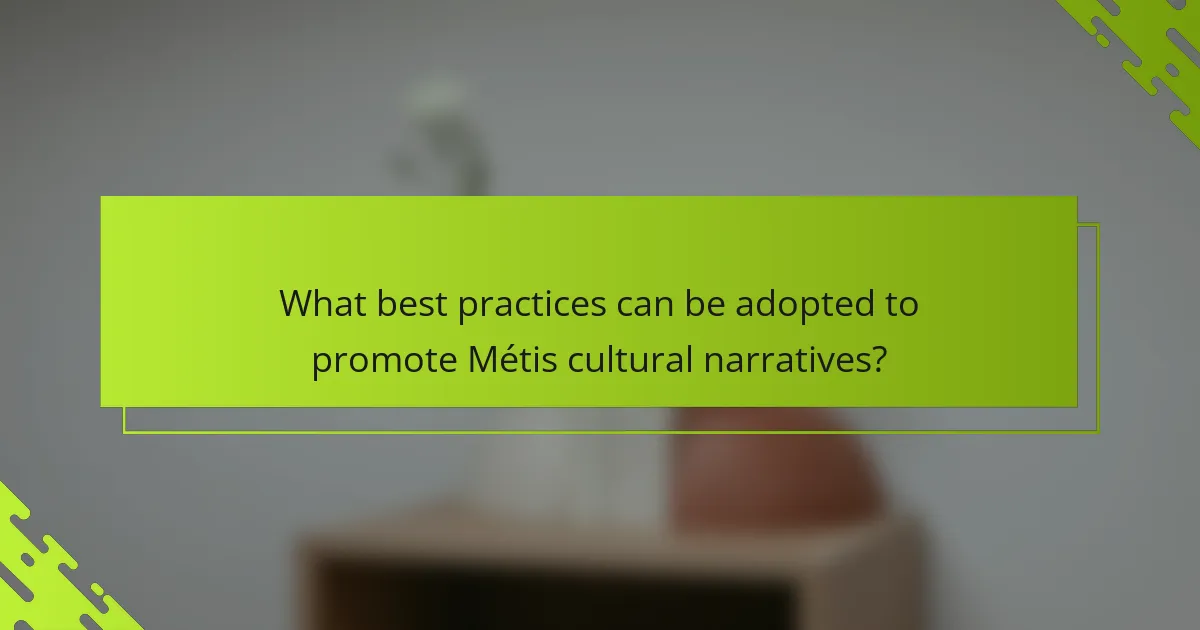
What best practices can be adopted to promote Métis cultural narratives?
Promoting Métis cultural narratives requires a multifaceted approach. Engaging storytelling, community involvement, and educational initiatives are essential practices.
1. Foster collaboration with Métis artists to showcase their work and narratives.
2. Integrate Métis history and culture into school curricula to educate future generations.
3. Utilize digital platforms to share narratives widely, reaching diverse audiences.
4. Organize cultural events that celebrate Métis traditions and storytelling.
5. Support the creation of resources that document and preserve Métis narratives for future generations.
How can individuals contribute to the preservation of Métis culture?
Individuals can contribute to the preservation of Métis culture by actively engaging in cultural practices and education. Participating in traditional events, such as Métis celebrations and festivals, fosters community connection and cultural pride. Supporting Métis artists and artisans helps sustain unique artistic expressions, which reflect the rich history and identity of the Métis people.
Additionally, learning about Métis history through literature, workshops, and community programs strengthens understanding and appreciation of their cultural narratives. Advocating for the inclusion of Métis history in educational curricula promotes broader awareness and respect for their contributions.
Collaborating with Métis organizations on preservation initiatives can amplify efforts to maintain language, storytelling, and traditional knowledge. By sharing these experiences and knowledge, individuals can play a vital role in ensuring the continuity of Métis culture for future generations.
What strategies are effective for engaging youth in Métis cultural narratives?
Engaging youth in Métis cultural narratives requires interactive and relatable strategies. Utilizing storytelling workshops fosters personal connections to history. Incorporating digital media, such as social platforms, allows youth to share their interpretations. Collaborative art projects encourage self-expression while reinforcing cultural identity. Community events that celebrate Métis traditions create immersive experiences, enhancing understanding and appreciation.
Which resources are available for learning about Métis history and culture?
Numerous resources are available for learning about Métis history and culture. Key sources include books, online databases, educational websites, and community organizations.
Books such as “The Métis: A Nation of People” provide in-depth insights into Métis identity and history. Online platforms like the Canadian Encyclopedia offer articles and multimedia resources. Educational institutions often have specialized programs focusing on Indigenous studies, including Métis culture. Community organizations, such as the Métis Nation, provide workshops and cultural events that promote understanding and appreciation of Métis heritage.
